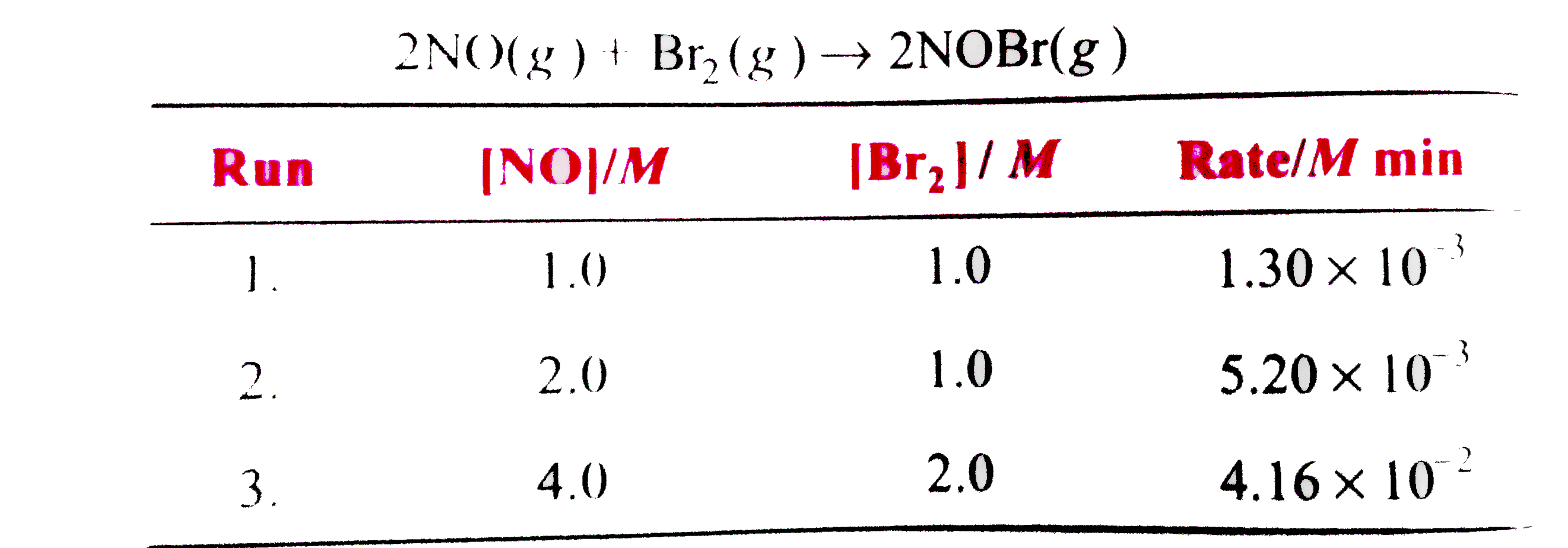In a 1-litre vessel at 1000 K are introduced 0.1 mole each of NO and Br2 and 0.01 mole of NOBr
2NO(g)+Br2(g)⇔2NOBr(g),Kc=1.32×10−2
Determine the direction of the net reaction and calculate the partial pressure of NOBr in the vessel at equilibrium.
The correct Answer is:Reverse, 0.30 atm
To solve the problem step by step, we will follow these steps:
Step 1: Write the balanced chemical equation
The balanced chemical equation for the reaction is:
2NO(g)+Br2(g)↔2NOBr(g)
Step 2: Identify initial concentrations
Given:
- Initial moles of NO=0.1mol
- Initial moles of Br2=0.1mol
- Initial moles of NOBr=0.01mol
Since the volume of the vessel is 1 liter, the initial concentrations are:
- (NO)=0.1mol/L
- (Br2)=0.1mol/L
- (NOBr)=0.01mol/L
Step 3: Calculate the reaction quotient Qc
The expression for the equilibrium constant Kc is:
Kc=(NOBr)2(NO)2⋅(Br2)
Substituting the initial concentrations into the expression:
Qc=(0.01)2(0.1)2⋅(0.1)=0.00010.01=0.01
Step 4: Compare Qc with Kc
Given Kc=1.32×10−2:
- Since Qc(0.01)<Kc(1.32×10−2), the reaction will shift to the right (towards the products) to reach equilibrium.
Step 5: Set up the equilibrium expression
Let x be the change in moles of NOBr at equilibrium. The changes in concentrations will be:
- (NO)=0.1−x
- (Br2)=0.1−x2
- (NOBr)=0.01+x
Step 6: Write the equilibrium expression in terms of x
At equilibrium:
Kc=(0.01+x)2(0.1−x)2⋅(0.1−x2)
Substituting Kc=1.32×10−2:
1.32×10−2=(0.01+x)2(0.1−x)2⋅(0.1−x2)
Step 7: Make assumptions to simplify calculations
Assuming x is small compared to 0.1, we can simplify:
- 0.1−x≈0.1
- 0.1−x2≈0.1
Thus, the equation simplifies to:
1.32×10−2=(0.01+x)2(0.1)2⋅(0.1)
Step 8: Solve for x
Rearranging gives:
1.32×10−2=(0.01+x)20.01
1.32×10−4=(0.01+x)2
Taking the square root:
0.0115≈0.01+x
Thus:
x≈0.0015
Step 9: Calculate equilibrium concentrations
Now, substituting x back:
- (NOBr)=0.01+0.0015=0.0115mol/L
Step 10: Calculate partial pressure of NOBr at equilibrium
Using the ideal gas law:
P=nRTV
Where:
- n=0.0115mol
- R=0.0821L atm/(K mol)
- T=1000K
- V=1L
Calculating:
P=0.0115×0.0821×10001≈0.946atm
Final Result
The partial pressure of NOBr at equilibrium is approximately 0.946atm.
---
The balanced chemical equation for the reaction is:
2NO(g)+Br2(g)↔2NOBr(g)
Given:
- Initial moles of NO=0.1mol
- Initial moles of Br2=0.1mol
- Initial moles of NOBr=0.01mol
- (NO)=0.1mol/L
- (Br2)=0.1mol/L
- (NOBr)=0.01mol/L
The expression for the equilibrium constant Kc is:
Kc=(NOBr)2(NO)2⋅(Br2)
Qc=(0.01)2(0.1)2⋅(0.1)=0.00010.01=0.01
Given Kc=1.32×10−2:
- Since Qc(0.01)<Kc(1.32×10−2), the reaction will shift to the right (towards the products) to reach equilibrium.
Let x be the change in moles of NOBr at equilibrium. The changes in concentrations will be:
- (NO)=0.1−x
- (Br2)=0.1−x2
- (NOBr)=0.01+x
At equilibrium:
Kc=(0.01+x)2(0.1−x)2⋅(0.1−x2)
1.32×10−2=(0.01+x)2(0.1−x)2⋅(0.1−x2)
Assuming x is small compared to 0.1, we can simplify:
- 0.1−x≈0.1
- 0.1−x2≈0.1
1.32×10−2=(0.01+x)2(0.1)2⋅(0.1)
Rearranging gives:
1.32×10−2=(0.01+x)20.01
1.32×10−4=(0.01+x)2
0.0115≈0.01+x
Thus:
x≈0.0015
Now, substituting x back:
- (NOBr)=0.01+0.0015=0.0115mol/L
Using the ideal gas law:
P=nRTV
Where:
- n=0.0115mol
- R=0.0821L atm/(K mol)
- T=1000K
- V=1L
P=0.0115×0.0821×10001≈0.946atm
The partial pressure of NOBr at equilibrium is approximately 0.946atm.
Topper's Solved these Questions
- CHEMICAL EQUILIBRIUMBOOK - RC MUKHERJEECHAPTER - CHEMICAL EQUILIBRIUMEXERCISE - Objective Problems
57 Videos
- CHEMICAL EQUILIBRIUMBOOK - RC MUKHERJEECHAPTER - CHEMICAL EQUILIBRIUMEXERCISE - Objective Problems
57 Videos
- ATOMIC WEIGHTBOOK - RC MUKHERJEECHAPTER - ATOMIC WEIGHTEXERCISE - PROBLEMS
6 Videos
- CHEMICAL EQUIVALENCEBOOK - RC MUKHERJEECHAPTER - CHEMICAL EQUIVALENCEEXERCISE - PROBLEMS
24 Videos
Similar Questions
The rate of formation of NO(g) in the reaction NOBr(g)→NO(g)+Br2(g) is found to be 1.6×10–4M/s. Find the rate of overall reaction rate and rate of consumption of NOBr.
View Solution(i) The equilibrium H2(g)+CO2(g)⇔H2O2(g)+CO(g) is established in an evacuated vessel at 723K starting with 0.1mol of H2 and 0.2 mole of CO2. If the equilibrium mixture contains 10 mole per cent of water vapour, calculate Kp, given that the equilibrium pressure is 0.5atm. Calculate the partial pressures of the component species and the volume of the container.
(ii) If now, into the flask, solid CoO and solid Co are introduced two new equilibrium are established.
CoO(s)+H2(g)⇔Co(s)+H2O(g), CoO(s)+CO(g)⇔Co(g)+CO2(g)
The new equilibrium mixture contains 30 mole per cent of water vapour. Calculate the equilibrium constants for the new equilibria.
View Solution
Knowledge Check
The following mechanism has been propsoed for the reaction of NO with Br2 to form NOBr.
NO(g)+Br2(g)⇔NOBr2(g),
NOBr2(g)+NO(g)→2NOBr(g) (slow step)
If the second step is the rate determining step, the order of the reaction with respect to NO(g) is:A1B0C3D2The following mechanism has been proposed for the reaction of NO with Br2 to from NOBr.
NO(g)+Br2⇔NOBr2(g)
NOBr2(g)+NO(g)→2NOBr(g)
If the second step is the rate determining step, the order of the reaction with respect to NO(g) isA2B0C0.5D1
The rate of formation of NO(g) in the reaction 2NOBr(h)→2NO(g)+Br2(g) was reported as 1.6×10−4mol−1sec−1. What is the rate of reaction and rate of consumption of NOBr?
View SolutionThe following initial rate data were obtianed for the reaction
2NOg+Br(g)→2NOBr(g)

Determine the reaction rat law and the value of te rate constant.
View Solution1 mol of nitrogen is mixed with 3 mol of hydrogen in a 4L container. If 0.25% of nitrogen is converted to ammonia by the following reaction
N2(g)+3H2(g)⇔2NH3(g)
then calculate the equilibrium constant Kc in concentration units. What will be the value of Kc for the following equilibrium?
12N2(g)+32H2(g)⇔NH3(g)
View SolutionThe equilibrium are simultaneoulsy existing in a vessel at 25∘C
NO(g)+NO2(g)⇔N2O3(g)Kp1(say)
2NO2(g)⇔N2O4(g),Kpx=8 atm−1
If initially only NO and NO2 are present in a 3:5 mole ratio and the total pressure at equilibrium is 5.5 atm with the pressure of NO2 at 0.5atm, calculate Kp1.
View Solution5 litre vessel contains 2 moles of each of gases A and B at equilibrium. If 1 mole each of A and B are removed. Calculate KC for the reaction A(g)⇔B(g)
View SolutionAt a pressure of 1.0 bar, an equilibrium exists at 2000 K between 0.25 mole of Br2(g) , 0.75 mole of F2 (g) and 0.497 mole of BrF3(g) . What will be the amounts of each gas after the pressure on the system has been increased to 2.0 bar and the equilibrium at 2000 K re-established?
Br2(g)+3F2→2BrF3(g)
View Solution
